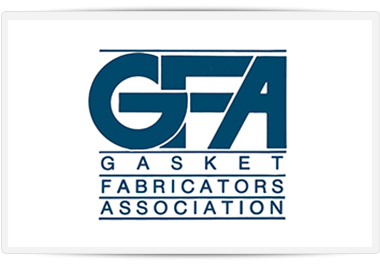A gasket seals the gap between two surfaces. They are cut to the shape needed for the specific application. Since there are so many possibilities when it comes to gasket materials, selecting the right gasket material boils down to understanding the gasket properties you need and your manufacturing process.
Purpose of the Gasket
The obvious purpose of a gasket is to provide a seal. But does it serve other purposes? Does it need to protect against corrosion, reduce vibration, or dampen noise?
The purpose of the gasket plays a key role in identifying the proper gasket properties.
Elasticity and Compressibility
Because gaskets fill gaps to create a seal, the two most important gasket properties to consider are elasticity and compressibility. These gasket properties go hand in hand.
Elasticity refers to the ability of the gasket material to recover size and shape after being exposed to a load. Gaskets compress under load. When the load is removed, the gasket material recovers. It may fully or partially recover in both shape and thickness.
This isn’t to be confused with creep. When the load is applied to the gasket material over time, the gasket material may reduce in thickness. This reduced thickness is referred to as creep.
The ideal gasket material maintains the seal as the gap between flanges changes and the compressive load varies. Sponge materials are less affected by compression and may be appropriate where the flanges are uneven or warped.
Adhesion
Is an adhesive backing necessary to aid in efficient product assembly? Or will the gasket be applied to highly slippery materials?
The adhesion properties of a gasket must be approached from two angles. First is the adhesion property of the gasket material itself.
For example, nitrile rubber is great for use for metal parts. It has high adhesion, so the gasket won’t slip and because it is resistant to oils, it can be used around automotive fluids. On the other hand, EDPM is difficult to bond and wouldn’t be appropriate for that application.
In addition to the adhesion properties of the gasket itself, you may need the gasket to be produced with an adhesive backing. This backing permanently bonds the gasket in the event the two parts become separated and peel and stick adhesives can speed the time it takes to manually install the gasket during production.
Abrasion
Abrasion resistance is the gasket property that refers to the ability of the material to resist mechanical actions. Sliding abrasion comes from forces such as rubbing and scraping while impingement abrasion comes from particles hitting the gasket material.
Many industrial fluids are abrasive in nature, and this must be considered when selecting gasket material.
Polyurethane and red rubber both have high abrasion resistance, making them well-suited for applications for slurries, wastewater, and other abrasive fluids.
Resistance to Ozone or Oxygen
Another important gasket property to consider is resistance to oxygen or ozone. Both are naturally occurring and not all gasket materials are suitable for use when one or both of these are present.
Oxygen oxidizes, that’s why metal rusts. The same destructive force that reduces the integrity of metal can reduce the integrity of your gasket material.
For example, EPR rubber is resistant to ozone, oxygen, and heat. This means it can be used in many outdoor applications. On the other hand, natural and synthetic rubber break down quickly and are not for use in outdoor applications.
Temperature Range
When considering gasket materials, you must consider two important temperatures. First is the temperature of the environment in which the gasket will operate. The second is the temperature of the gas or fluid that is being carried.
For example, pipes exposed to the sun in a hot climate could experience an external temperature variation of 40° or more during the daytime while the temperature of the fluid or gas inside stays the same.
On the other hand, system start-up or shut down may cause the gas or fluid to change temperature (such as water in a boiler system) as the external environment remains fixed.
The gasket material you select must operate at the high and low end of both internal and external temperatures. This isn’t a problem for materials like neoprene that can handle temperatures as high as 212°F or as low as -30°F.
Thermal Insulation
Some gaskets need to do double duty and provide insulation. There might not be room for a heat shield or a cooling system to offset heat soak.
In these instances, you need a gasket with high thermal insulation properties. Thermoplastic and thermoset polymers offer thermal protection and can be used as insulators for electrical systems.
Electrical Resistance
Do you need a gasket to absorb electromagnetic interference and radio frequency interference? If so, then the gasket material must fill gaps and complete the grounding path.
Maybe you need gaskets that won’t generate static charges or divert existing ones away from sensitive electronics.
EDPM diverts electrostatic charges quickly and might be a possible solution.
Chemical Resistance and Reactivity
Will the gasket encounter petroleum-based fluids? This is an important consideration in selecting gasket material.
Many gasket materials are not suitable for use around gasoline, oil, and other petroleum-based fluids. Nitrile Butadiene (NBR) can be used around petroleum-based fluids and at elevated temperatures.
Frank Lowe Reduces the Complexity of Understanding Gasket Properties
It’s easy to be overwhelmed by the number of gasket materials on the market today. Frank Lowe makes selecting the proper gasket for your needs easy.
Just connect with our team, tell us about your project, and we’ll explore your options and help you pursue the solution that makes the most sense. We are more than gasket die-cutters, we are solution engineers.
And once you’ve selected Frank Lowe as your gasket supplier, you can breathe easier knowing your gaskets will always be ready when you need them.
We even offer a set-it and forget-it Blanket Ordering program so your parts arrive on a predetermined schedule.





